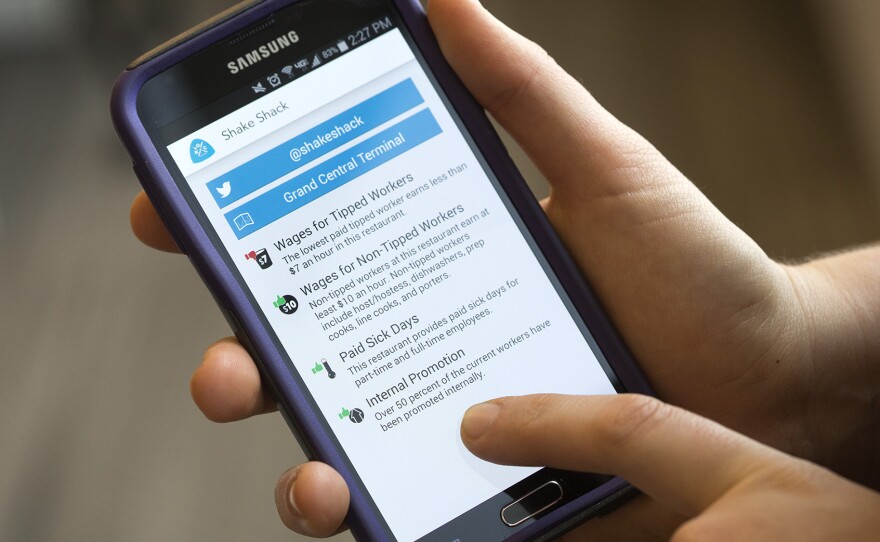
Restaurant servers are three times more likely to receive below-poverty-line pay than the rest of the U.S. workforce. Yet in a world where shoppers fret over cage-free eggs and organic vegetables, how many are also asking how much their favorite restaurant pays its staff?
An app from Restaurant Opportunities Centers United, an organization of restaurant workers, employers and customers, aims to encourage diners to ask those kinds of questions about the welfare of industry workers. Think of it as a kind of Yelp for labor rights.
The ROC United Diners' Guide app lets diners investigate the policies at restaurants in the U.S. When a user enters her location, the app brings up a few local restaurants and shows whether they pay their staffs a living wage and offer a few basic benefits, like paid sick leave. When the user swipes left, the app shows and evaluates the top 100 chain restaurants in the U.S. – so you can see how they stack up.
The app actually rolled out a couple of years ago, but an updated version offers a new twist: crowdsourcing. ROC officials hope this component will quickly help expand the list, which currently offers detailed information for only about 150 restaurants.
If your restaurant of choice isn't on the list, the app encourages you to talk to a manager about the establishment's policies. Users can then create an entry for the restaurant and fill out as much as they know about its wages and practices. The information they submit goes to ROC's staff, who verify the details before adding it to the list of restaurants.
That feature isn't just about enlisting diners to do ROC's legwork, says Maria Myotte, the group's national communications coordinator. Every time diners reach out directly to a restaurant manager, they are demonstrating that these issues are important, she says.
"We want it to be less of an easy 'here's what you can use' list and more of an engagement tool," Myotte says.
Non-chain restaurants listed on the app appear under a category called "high road." They are rated on four different criteria.
The first and second criteria are related to wages: The restaurant must pay its non-tipped workers at least $10 an hour. And tipped staff must earn at least $7 an hour to make the list. That's higher than the federal minimum wage for anyone who earns tips — just $2.13 an hour, a number that hasn't increased since 1991. (As we've reported, some states have higher tip minimum wages.)
Next, the restaurant must give all employees paid sick days. "Working while sick is so commonplace," says Myotte, because most restaurant workers can't afford to take a day off without pay.
"We have heard from our workers that they face termination or [that] colleagues have been fired for not showing up" when they are sick, says Myotte.
Paid sick days, Myotte says, should really be a no-brainer. Foodborne illness moves quickly through restaurants. Because so many people touch the food, it's easy for germs to spread from restaurant staff to customers.
Finally, the restaurant must have a nondiscriminatory program for internal promotion. "A majority of actual living-wage restaurants are in fine dining," says Myotte, "but they're dominated by white workers, especially white men."
She says many restaurants have qualified applicants of color already working inside their doors, but in lower-paying positions like busboys or dishwashers. Those workers, she says, often don't get considered when management is looking to fill higher-paying, front-of-the-house positions.
"A lot of the servers are hired externally, even though there's qualified staff right there at the restaurant," says Myotte. Hiring from within might help decrease the $4 wage gap that ROC United found between white and black restaurant employees when they surveyed more than 4,000 workers.
I opened up the app here in Washington, D.C., to see who's ethically serving my lunch. Shake Shack appears on the list — but the nearest location, the app tells me, is Grand Central Terminal, in New York City. For the record, the closest one is actually about a 10-minute walk away.
Location snafu aside, according to the ROC app, Shake Shack meets all criteria for a "high road" restaurant except for one: the wages for tipped workers. But this isn't quite accurate — Shake Shack doesn't have tipped workers, so how could it be underpaying them?
"It's a little wonky on the back end to remove that standard," Myotte admits, but she says that ROC United is working on this technical issue. "What we want to make it do is specify that those restaurants don't have tipped workers."
Indeed, very few of the restaurants listed meet all four of the "high road" criteria. But with enough pressure from consumers, ROC United expects restaurants to shape up.
"There's more than just a few restaurants in cities doing this," says Myotte.
Copyright 2015 NPR. To see more, visit http://www.npr.org/.






